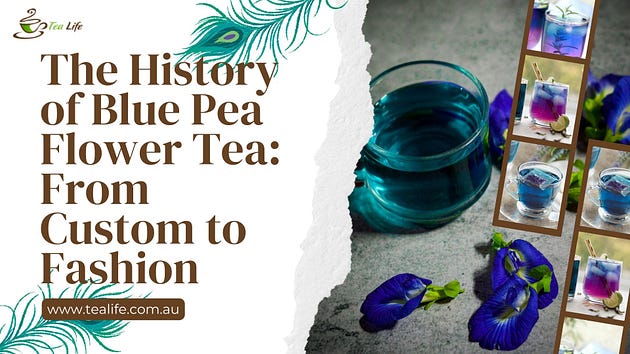The History of Blue Pea Flower Tea: From Custom to Fashion

With its eye-catching hue and plethora of health advantages, Blue Pea Flower Tea has quickly become a favorite in the contemporary tea industry. However, this colorful tea has a long history that is firmly anchored in antiquated customs, even if it may seem to be a stylish new addition to your neighborhood tea store. Let’s examine the history of Blue Pea Flower Tea and its transformation from a traditional medicine to a contemporary health beverage.
The Origins of Blue Pea Flower Tea in Tradition
Butterfly pea tea, another name for blue pea flower tea, comes from Southeast Asia and has been used in traditional medicine there for millennia. The dried petals of the Clitoria ternatea plant, often known as the butterfly pea flower, are used to make the tea. This plant is indigenous to Thailand, Malaysia, and Vietnam, where its vivid blue hue has long been used in regional cuisine and health rituals.
Blue Pea Flower Tea has long been prized for its therapeutic qualities in Ayurvedic and traditional Thai medicine. It has been used to treat a variety of illnesses, from enhancing memory and brain function to lowering stress and anxiety. The tea is also a powerful anti-inflammatory and immune-stimulating beverage because to its high content of flavonoids and antioxidants.
Blue Pea Flower Tea’s Ascent in Contemporary Tea Shops
Blue pea flower tea has evolved from a local herbal medicine to a worldwide health and wellness fad in recent years. Because of its inherent color change — from deep blue to purple when lemon juice is added — it has become a favorite among social media influencers and health-conscious customers. Its popularity in hip cafes and tea shops worldwide may be attributed in large part to this distinctive quality.
In addition to its captivating hue, Blue Pea Flower Tea is valued for its subtle, earthy taste that blends nicely with a wide range of other ingredients. In order to make pleasant and distinctive drinks, many tea stores now offer imaginative mixes that use Blue Pea Flower Tea. These blends often combine the tea with tastes like ginger and mint or herbs like lemongrass.
Advantages for Health and Current Uses

Due to its various health advantages, Blue Pea Flower Tea is becoming more and more popular, and many tea stores are selling it as a superfood. The antioxidants in the tea aid in the body’s defense against free radicals, resulting in better skin and a lower chance of developing chronic diseases. Its relaxing qualities also make it the ideal beverage for mental clarity and stress reduction.
Tea Life offers Blue Pea Flower Tea.
Tea Life is the best spot to try Blue Pea Flower Tea, regardless of whether you’ve been a fan for a long time or not. Both traditional tea fans and those looking for a contemporary touch will adore the variety of premium Blue Pea Flower Tea blends that our tea store provides. Explore our selection at Tea Life right now to see how Blue Pea Flower Tea might improve your everyday tea routine.
.jpg)
Comments
Post a Comment